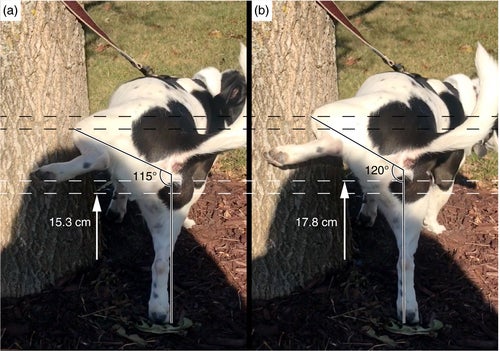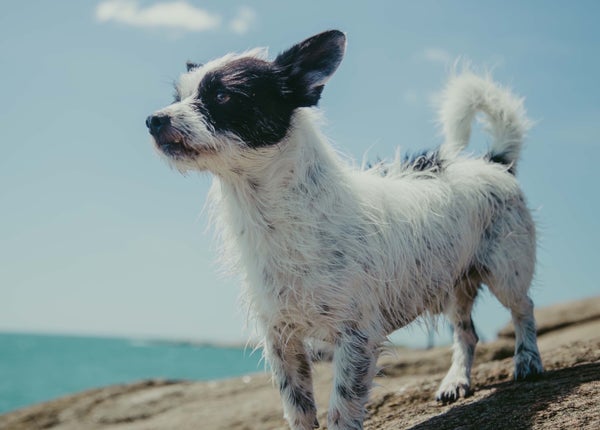This article was published in Scientific American’s former blog network and reflects the views of the author, not necessarily those of Scientific American
Betty McGuire is no stranger to dog urine. If you live with a dog, neither are you. I’m guessing your dog pee story is probably one of waiting: Waiting while your dog checks out another dog’s pee, or waiting while your dog leaves a deposit. And who hasn’t experienced the occasional, “Ack! Why did you pee there?!?” followed by a cleaning session. But if you’ve ever gazed at a peeing dog and asked yourself any number of “Why” questions, Betty McGuire is the person for you.
McGuire, a researcher and senior lecturer at the Department of Ecology and Evolutionary Biology at Cornell University, studies dog urinary behavior. Her research looks at the complex amalgam of dog factors — like age, sex, reproductive status, height, and body size — that contribute to how and where dogs pee. For over ten years, McGuire and her colleagues have shown there’s not one way to look at a peeing dog. Her scientific studies have tackled topics like dog urinary posture — including the squat, squat-raise, arch-raise, combination, and yes even the handstand (which I covered here) — motor laterality, i.e.,which hind-limb dogs lift when peeing, and scent-marking behaviors like ground scratching.
McGuire conducts much of her work in collaboration with local SPCA animal shelters. “Our research provides shelter dogs with additional opportunities for exercise and socialization, as well as chances to display species-typical behaviors,” she explains on her website. Also, animal shelters are great places to watch a lot of dogs pee.
On supporting science journalism
If you're enjoying this article, consider supporting our award-winning journalism by subscribing. By purchasing a subscription you are helping to ensure the future of impactful stories about the discoveries and ideas shaping our world today.
Even if you don’t think much about dog pee, McGuire’s latest question has probably crossed your mind: when a dog pees on an object like a tree or a fire hydrant, do some dogs aim their pee to land “higher up” on the vertical surface than other dogs? Does what I’ll call Pee Height — where the urine lands — accurately represent the size of the urinator? (“The Urinator” must be the name of a rejected Marvel superhero.) McGuire and colleagues’ study was recently published in the Journal of Zoology.
First, the basics: Adult male dogs tend to raise a back leg to pee; juveniles tend to assume a lean-forward posture; and females tend to squat. (Of course, if you’re thinking, “Not my dog!” you’re right. Individual dogs can deviate from these trends, as I cover here). Dog researchers love dog pee (for research purposes only, they swear) because dog urine isn’t merely for excretion. It carries social information about individuals, like sex, age and reproductive status. Pee Height, too, might provide information to other dogs. The hind-leg raise attracts attention because, in this position, dogs have the most control over urine placement.
To explore whether a dog’s Pee Height reflects the dog’s size, McGuire and colleagues recorded adult male mixed-breed dogs, both intact and neutered, out on walks at two animal shelters. The researchers excluded juveniles who might not raise a leg and seniors who might not raise due to orthopedic issues. The researchers accounted for factors like body size — height and mass — and used the videos to measure raised-leg angle during urination as well as urine mark height (Pee Height).
The researchers found that in some cases, Pee Height accurately reflected the size of the urinator. This means if you’re a dog checking out pee on a fire hydrant, the height of the pee you’re sniffing could tell you about the size of the dog who left it.
But small dogs didn’t fit the pattern. McGuire and colleagues found that, on average, small dogs raised their legs higher when peeing, which increased their angles, and resulted in their pee hitting higher than the dogs’ height might predict. There is no better use of trigonometry. “Thus, even though height of urine mark does reflect size of signaler in part,” the researchers observe, “small dogs seem to ‘cheat’ by using larger raised-leg angles to deposit higher urine marks, thereby exaggerating their size.”
If you think you’re going to read this piece without an exceptional visual example, you are incorrect. Meet Patches. As shown below, his leg begins at 115 degrees to produce a urine mark with a Pee Height of 15.3 cm. Then, during the same urination — and without shifting his planted legs or moving closer to the tree — Patches raises his leg higher to 120 degrees to achieve a Pee Height of 17.8 cm. Bravo, Patches. Bravo.

Figure 2 featuring Patches. Credit: McGuire et al. 2018
Exactly why small dogs aim high remains to be seen. One hypothesis involves the intersection of two concepts: dogs use pee as part of communication, and small dogs might engage in more indirect forms of communication because direct social interactions could be more costly for them. For example, in a 2017 study, McGuire and Bemis observed that small dogs urine mark more frequently than large dogs, spreading themselves around more than large dogs. And by increasing their Pee Height, what might be happening is that small dogs are using pee to exaggerate their own size and possibly aid in avoiding conflict.
Another potential explanation is that small dogs might perform these leg lifting exercises in an attempt to “over mark” — pee on top of another dog’s pee. Mammals, including dogs, use over marking to cover others’ deposits with their own scent, and dogs of all sizes seem to over mark. Of course, the higher a dog’s Pee Height, the more urine a dog can potentially over mark. Due to their natural height advantage, larger dogs don’thave to work their leg much to over mark, while smaller dogs need to limber up. Maybe attempting to over mark is what prompts smaller dogs to perform these acrobatics in the first place, a possibility that should be explored — and controlled for — in future studies, the researchers add.
There’s also the possibility that larger dogs might be physically constrained from lifting their legs higher. Because dogs often lean in the opposite direction of the target during raised-leg urinations, larger dogs might be limited in how high they can lift without toppling over. No one wants to fall over mid-pee. Not even dogs.
And then there are the dogs who lift and miss. The researchers note that “dogs sometimes miss targets, especially poles and tree trunks of small diameter…” It remains to be seen if there are any trends or patterns in who lifts and misses. If social meaning is being attached to where deposits “land,” but some deposits don’t “land,” how might poor aim affect dog social interactions? Do they even know they missed?
Because McGuire’s study was observational, experimental studies exploring why small dogs tend to aim high, and how dogs respond to urine encountered at different heights, is a much-anticipated next step.
Reference
McGuire, B., Olsen, B., Bemis, K. E., & Orantes, D. (2018). Urine marking in male domestic dogs: honest or dishonest?Journal of Zoology, First published online: 25 July 2018
Want to talk about this piece? Visit me at Dog Spies on Facebook or Twitter.
